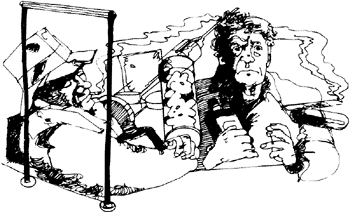![[MetroActive News&Issues]](/gifs/news468.gif)
[ Sonoma County Independent | MetroActive Central | Archives ]
Ill Health
Local health report card: Drug-related deaths and suicides top state averages
By Janet Wells
REFLECTING A TREND that county health officials call a "major problem," a report released this week by the California Department of Health puts Sonoma County in the top echelon for the number of deaths from suicide and drugs. Sonoma County ranks 13th highest in the number of drug-related deaths, and 15th highest in number of suicides.
Coming on the heels of the suicide of a Sebastopol teenager whose brother died of alcohol-related causes less than six weeks later, the report's findings "speak to very complex issues involving social and quality-of-life factors," says Sonoma County Public Health Officer Dr. George Flores. "If there is not adequate family support or if despondency grows out of lack of housing or a job, substance abuse, or domestic violence, suicide becomes a viable alternative for people who are depressed enough or sick enough," he says.
Sonoma County's average of 72 suicides annually in 1995-97 is higher per capita than that of either Marin or San Francisco County because there is a proportionately larger population of retirees, Flores says, and the suicide rate is higher among the elderly.
"This tragedy seems even more compelling when we hear of a young person," Flores adds, referring to the deaths of 17-year-old Kyle Caldwell by a self-inflicted gunshot wound in February and his brother, Gene, after drinking at a party in March. "Somehow their needs weren't being met. A situation arose that put them in a position of great tragedy. We need to do better."
Since last year Sonoma County leapt seven rankings in the number of drug-related deaths. "I've been saying for years that we are in an area where things come together for a lot of drug usage," says Michael Spielman, executive director of the Drug Abuse Alternatives Center in Santa Rosa.
Drug use is directly linked to drug access, Spielman says. The primary drugs that contribute to the death rate are amphetamines, cocaine, and heroin. "You can die 20 different ways from each," he says.
In Sonoma County the drug of choice for adults is amphetamines, with 55 percent of Spielman's adult clients stating that it is their main drug problem. Forty percent of the teenagers participating in programs at the center have tried the drug, which is manufactured locally at clandestine labs.
Cocaine and heroin aren't as prevalent in the county, but increasing purity has contributed to more overdoses.
"Black-tar heroin from Mexico is 50 to 60 percent pure, compared to 5 percent 20 years ago, and it's relatively cheap," Spielman says.
The Drug Abuse Alternatives Center offers several treatment and education programs for teenagers and adults. But, says Spielman, the death rates are likely to continue rising unless more money comes available.
"The war on drugs really wasn't very successful," he says. "Of the $18 billion spent nationally, $13 billion was spent on cops and just $5 billion on prevention, education, and treatment. Keep spending $13 billion on cops, but spend $13 billion on treatment. The goal is quality treatment on demand for anyone who needs it."
DRUG-USERS asking for placement at the center's nine-month 58-bed residential treatment program typically wait six months to a year. Spielman is proud of a recent survey that showed 100 percent of the residential program clients had stopped or significantly reduced drug use.
"When they are waiting, they are either continuing to use drugs, stealing, and doing all the things drug addicts do, or they are waiting in jail, where it costs far more money to keep them," Spielman says. "If you look at people who have had a drug problem and went to jail, you're lucky if maybe 20 percent stopped or reduced drug use."
Dr. Flores also is frustrated by funding priorities. Of the county's $18 million public health budget, 1 percent is spent on prevention.
"After someone is ill, we're essentially chasing the cow after it has escaped the barn," Flores says, adding that he would like to see at least 6 percent of his budget used for prevention. "We can save public resources as well as lives and preserve health if we focus our resources."
The 1999 County Health Status Profiles report, released to coincide with Public Health Week, also has some good news for Sonoma County, which leads the state in availability of prenatal care and in the fewest number of measles cases. The number of AIDS cases--while still high compared to other counties--decreased since the last state report, and the county improved its rating on other communicable diseases such as tuberculosis and syphilis.
"In the infectious diseases we seem to be doing a relatively good job, but we should not become complacent, because there are emerging infections at the same time," Flores says.
"There is concern about tick-borne diseases and chlamydia, a sexually transmitted disease with enormous infection rates among teenagers."
FLORES emphasizes that public health is a community responsibility. "Every time we get these reports we expect that raising the level of awareness of the community about health conditions will encourage people to make efforts to do what is necessary in their own families, schools, neighborhoods to improve health conditions as well as to support programs with these same goals," he says.
"It's not simply a matter of expecting the government to do it for you."
[ Sonoma County | MetroActive Central | Archives ]
Copyright © Metro Publishing Inc. Maintained by Boulevards New Media.
![]()

From the April 8-14, 1999 issue of the Sonoma County Independent.